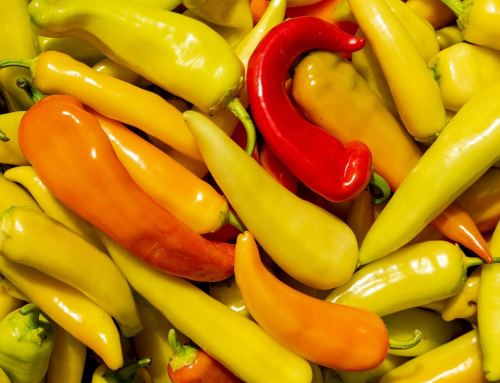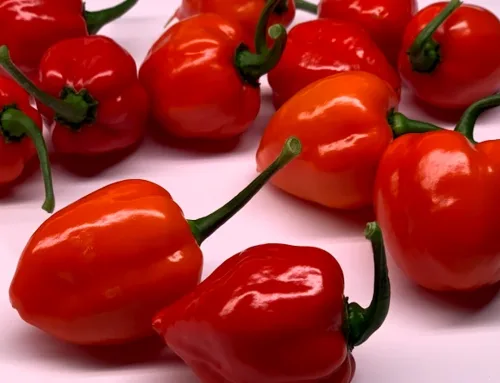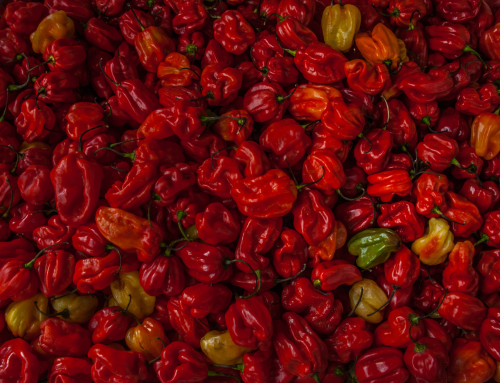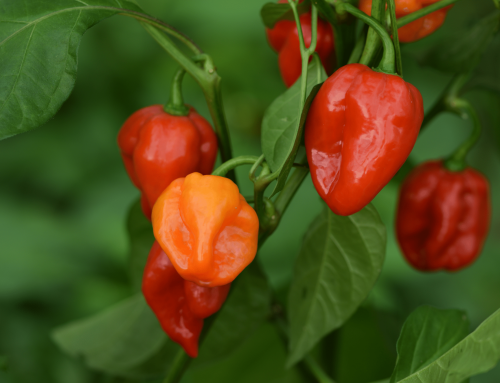If you are a fan of hot sauces or spicy peppers, you probably know something about the Carolina Reaper – the record-breaking, exceptionally flavorful chili pepper that is a unique gift to humanity. In this guide, you will find everything you need to know about the history and science behind Carolina Reaper, which has a fiery reputation of being one of the hottest peppers on this planet.
What Is a Carolina Reaper Chili Pepper?
Carolina Reaper is officially the hottest chili pepper in the world, according to the Guinness Book of World Records. It is a hybrid chili pepper that was created after crossbreeding some of the hottest peppers from around the globe.
The heat level of chili peppers is measured in Scoville Heat Units (SHUs) and the Carolina Reaper has been measured to have an average heat level of 1.4 million SHUs. The maximum recorded heat level ever for the Reaper is around 2.2 million SHUs.
To put things in perspective, the humble jalapeño pepper has a heat level that is somewhere between 2,000 and 7,000 SHUs. A tabasco pepper is between 30,000 to 50,000 SHUs, and even the mighty habanero is far behind at 100,000 to 250,000 SHUs.
The Origin and History of Carolina Reaper
Some peppers, like the Carolina Reaper, are not naturally occurring plants. Instead, they are created from existing plant varieties (or cultivars) by master breeders. The process is quite similar to breeding animals like dogs or horses – the plants just require more care and attention.
In the last half-century or so, there has been considerable interest in the quest to create the spiciest chili peppers possible. Enthusiastic breeders across the US, UK, Australia, and Europe compete with each other in an ever-escalating chili arms race.
Tracing the Lineage of the Reaper
The pepper breeder used two exceptionally spicy cultivars of the Capsicum chinense species of chili peppers to create the Reaper. Originally a native species from the Americas, C. chinense pepper variants are cultivated all around the globe. They include:
- Habanero (Caribbean, Mexico, Central America)
- Bhut Jolokia/Naga Chili (North-east India)
- Scotch Bonnet (Jamaica)
- Fatalii (South Africa)
The Carolina Reaper is the progeny of two peppers from the list above – a variant of the Habanero from the Caribbean, and a Naga Chili from the Indian sub-continent. Let’s take a closer look at the parent cultivars of the Reaper.
Maternal Plant – Habanero Pepper
The exact genetic make-up of the habanero used to breed the Reaper is not publicly known. We do know that the plant literally has lava in its veins. La Soufrière is an active volcanic island in the Caribbean nation of Saint Vincent and Grenadines.
The particular cultivar of habanero used by the reaper’s breeder was sourced from a friend who owned a resort on the island. A crossbreed in its own right, La Soufrière pepper was selected due to its unusually high heat levels.
Grown in the fertile volcanic soil on the island, La Soufrière adds its own trademark “kick” and an element of mystery to the story of the Carolina Reaper.
Paternal Plant – Naga Chili Pepper
The northeastern parts of India are home to some of the hottest chilies cultivated on Earth. These C. chinense cultivars go by different local names, which are often quite colorful. The most popular name is Bhut Jolokia from the state of Assam – it literally means “Ghost Pepper.”
The Naga chili and Ghost Pepper are generally acknowledged as two names of the same general cultivar. The paternal plant of the Reaper also comes with its own share of mysteries. Reapers’ breeder claims that he received the pepper as a gift from a Pakistani doctor.
Calling the pepper a Pakistani Naga has given rise to a fair bit of confusion since the country is not generally known as a center for the cultivation of such peppers. But since Pakistan lies right next to India and shares the same culinary heritage, a Pakistani Naga is not a very far-fetched idea.
Carolina Reaper Pepper Breeding History
Fascinated by the high spice levels of La Soufriere and the Pakistani Naga, the reapers’ breeder decided to experiment with the creation of an even more potent hybrid pepper. When he started out, there was no clear intention to create the world’s hottest pepper.
Even with the unique parentage, the breeder was taken aback by the sheer punch of heat from one of the hybrids. It was initially called the HP22B – in other words, “high power plant B from pot 22” in the master breeder’s breeding plan.
Over 7 generations, HP22B was cultivated and perfected into the chili we know today as the Carolina Reaper. The name is derived from two aspects of the pepper:
- Carolina since it was created in the state of South Carolina.
- Reaper because the pepper has a curved tail at the bottom of the pod, resembling a reaper’s scythe.
Carolina Reaper Chili Pepper Appearance
The Reaper shares some of the hallmark features of both its parents while retaining a unique appearance of its own. It is shorter than a habanero or a Ghost/Naga Pepper, measuring between 2–3 inches in length.
The overall shape is also quite squat and rounded, with a very wrinkly and bumpy surface – a feature it inherited mainly from the Naga chili. The Reaper also has a very distinctive tail, which looks curved like a scythe or a scorpion’s stinger.
When young, the peppers start off with a dark green shade. As they ripen, the colors slowly change to orange and then a fiery deep red. Brown variants of the chili pepper have also been noted by various growers.
Carolina Reaper Taste and Flavor Profile
While its extreme spiciness is a given, what is somewhat surprising about the Carolina Reaper is its rich flavor profile. Before the heat kicks in, consumers have reported a pleasant sweetness, combined with a fruity aroma.
Expert tasters have noted hints of cinnamon and chocolate in the flavor of the Reaper. While the heat level of the pepper is often compared to “swallowing hot lava,” the aroma, sweetness, and flavor make it an excellent addition to sauces and spice powders.
The Science Behind the Extreme Heat of Carolina Reaper Peppers
Chilies, or chili peppers as they are often called, derive their heat from a family of chemicals called capsaicinoids. In contrast, regular black peppers get their spiciness from a chemical called piperine. As an aside, Chinese Sichuan peppercorns do not belong to either category – they are a type of berry not related to chili peppers or black pepper.
Since it is a chili pepper, the Carolina Reaper is also rich in capsaicinoids. The most abundant chemical in this family is called capsaicin. Breeders try to develop chili peppers with the highest capsaicin content in their attempts to create the spiciest pepper.
In fact, the Reaper belongs to a new category of chili peppers that are loosely called “super-hot peppers.” These are hybrid varieties whose Scoville Units go into the six-figures. These hot peppers are different from traditional chili peppers in the quantity and location of capsaicinoids.
The Placenta or “Pith”
In regular peppers like serrano, poblano, and so on, the capsaicin is concentrated more in the inner regions of the fruit, which is colloquially called the pith. The technical term for this area is the “placenta” – a region where the chili seeds attach to the top of the fruit.
Many people believe that chili seeds are the main source of heat. This is not correct – it is the placenta or pith that accounts for the highest concentration of capsaicinoids. But with super-hot chilies like the Carolina Reaper, the chemicals are not just located in the pith.
Instead, these new-age chilies have a more even distribution of active compounds all over the fruit, especially in the pericarp. This is nothing but the outer body of the chili pepper, the skin-like substance that protects the seeds.
In regular chilies, you can reduce the intensity of the heat considerably by removing the placenta and seeds. However, this will have a more limited impact on the Carolina Reaper since the outer flesh also contains high levels of capsaicin and other capsaicinoids.
The Impact of a Carolina Reaper on the Body
The main active ingredient in the Reaper chili is capsaicin. High levels of capsaicin can trigger several painful reactions in the human body. When you bite into a Carolina Reaper, you can expect the following reactions:
- Extreme burning sensation in the mouth and throat.
- Tearing up of the eyes.
- Release of mucus from the nose.
- Redness of the skin and excessive sweating.
Capsaicin triggers an extreme pain reaction in the body. In the human body, there is a protein called TRPV1. It helps regulate body temperature, detect heat, and also in feeling the sensation of pain and burning.
When capsaicin comes in contact with TRPV1 in our mouths, it activates the protein and sends a warning signal to the brain. In response, the brain sends back signals of burning pain to the spot. Biting a serrano pepper (10,000 to 20,000 SHU) can trigger a reaction similar to touching a burning hot object.
You can imagine the sheer mind-numbing impact 1.5 million SHUs can have on the body. The important thing to note here is that capsaicin does not cause actual tissue damage, unlike a scalding hot object.
Over time, the body will recognize that the pain reaction is basically a sham. In some people, the pain eventually converts into a pleasant sensation. These are the so-called chili-heads – people who derive great enjoyment and pleasure from eating extremely spicy chilies and using them in food.
Safety Precautions When Using Carolina Reaper Chilies
The primary risk from Reaper chilies arises from their high concentration of capsaicinoids. In individuals who have developed a resistance to these compounds over time, handling or eating the chilies will produce minimal reactions.
On the other hand, in individuals who don’t have a high tolerance level for spice/heat, the Carolina Reaper can cause severe burning, pain, and other symptoms of extreme discomfort. In fact, it is highly recommended that you use protective equipment when handling Carolina Reapers.
During harvesting or tending to the plants, cultivators wear protective gloves. This rule also applies during cutting and handling the super-hot peppers in a kitchen. Furthermore, while cooking a dish with a high quantity of these peppers in it, wearing a protective mask and/or goggles for the eyes is recommended.
Moderation is essential when dealing with an explosive chili like the Carolina Reaper pepper. Excessive consumption can result in stomach issues and may even require hospitalization. If you suffer from gastric issues like ulcers, it would be wise to stay away from any super hot chilies.
Health Benefits of Carolina Reaper Chilies
When consumed in moderation, Reaper chilies may provide the same benefits as any regular chili peppers. The spice content in the peppers acts as a preservative and inhibits the growth of harmful bacteria. This is why people in hot, tropical climates use a ton of spices in their cuisine.
Capsaicin can also reduce inflammation, provide relief from pain, clear a stuffy nose, and help speed up the body’s metabolism (potentially aiding in weight loss). Chilies also contain healthy doses of vitamins like A, B, C, and E. They are rich in minerals like copper and potassium as well.
Growing Carolina Reapers at Home
Carolina Reaper peppers are quite easy to grow at home, provided you have the ideal growing conditions in your area. The plants require at least 64°F to 68°F temperatures but actually thrive in the mid-80°F ranges. If you live in colder locations, you may need to grow them in a greenhouse.
Although they tend to grow well in medium-sized pots (3-gallon size), the Reaper plants do require a good deal of space, especially vertical. The plants can reach up to 6 feet in height. Though they work best in direct soil, these peppers can also be grown hydroponically.
After the germination of Carolina Reaper seeds, you can expect your first harvest usually within three months. At this stage, the fruits will be red and ripe. You may also pick green chilies – they will ripen even after picking. A Carolina Reaper will continue bearing fruit throughout the growing season in ideal temperature conditions.
Reaper chilies do not require excessive irrigation. Fertilizers used to grow tomatoes and other vegetables work wonders on these chilies. Avoid nitrogen-based fertilizers for best results. When properly cared for, Carolina Reapers can grow for a maximum of 6 to 10 years.
How to Cook with Carolina Reaper Peppers
Due to its combination of high heat, sweetness, and rich fruity flavors, the Carolina Reaper is a very versatile chili pepper. Even a small sliver of the chili is enough to spice up a reasonably large pot of food. Extreme caution is advised while handling Reaper chilies in the kitchen.
The fermented pepper mash or pepper puree can be used to create hot sauce and marinades. For meat and vegetables, it can be dried and added as a spice powder to curries and other dishes or can be dehydrated and converted into chili flakes for garnishing. In tiny portions, they can enhance any dish, particularly spicy foods from Mexican, Indian, and Thai cuisines.
Always wear gloves when cutting chilies and don’t forget to wash your hands and other surfaces that come in direct contact with the extremely hot peppers. Any accidental contamination of the eyes or nose will trigger reactions similar to those of getting hit by a dose of pepper spray.
In no time, you’ll be able to create your own hot sauce and will be eating super-hot peppers at every meal!
Carolina Reaper Controversies and Future
The Carolina Reaper is officially recognized as the world’s hottest chili pepper, having surpassed Ghost Peppers by far. However, it received this award way back in 2017. Over the last few years, several other hot peppers have been developed by breeders, including the reaper’s creator himself.
A pepper, called the Dragon’s Breath Pepper, has surpassed Reaper’s score with a reported measurement of 2.4 million SHUs.
As the Carolina Reaper’s predecessor on the throne, the Trinidad Scorpion’s reign at the top only lasted for 3 years. Although newer claimants have come up for the title of the world’s hottest chili, they have not received official verification for one simple reason – credibility.
The chili breeding scene is incredibly competitive. Breeders come up with potent new strains each year. Having the title change hands frequently would diminish the value and credibility of the award considerably – this is a major reason why the Guinness authorities have declined to update the chili rankings.
It is only a matter of time though – with some chilies already crossing the 1.5 million SHU mark, the Carolina Reaper will probably lose its title in the near future. But that will not diminish its reputation as a chili not to be trifled with – the Carolina Reaper will still pack a fearsome punch!
Choose Magic Plant Farms for the Finest Carolina Reaper Products
At Magic Plan Farms, you can order a plethora of superlative quality Carolina Reaper products, including pastes/mash/purees, dried chili pods, chili powder, and chili flakes. Available quantities range from 9 oz jars to 55 gal drums. When the reaper came out, it wasn’t a stable landrace, so Magic Plant Farms’ agronomists worked on the reaper in 2013 to improve its heat level and yield, and stability dramatically. We believe now that we have the hottest Carolina Reaper on the market! For the finest quality Carolina Reaper pepper products, visit our online storefront using this link.






Leave A Comment